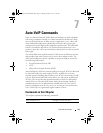
Auto-VoIP Commands 311
7
Auto-VoIP Commands
Voice over Internet Protocol (VoIP) allows network users to make telephone
calls using a computer network over a data network like the Internet. With
the increased prominence of delay-sensitive applications (voice, video, and
other multimedia applications) deployed in networks today, proper QoS
configuration ensures high-quality application performance. The Auto-VoIP
feature is intended to provide an easy classification mechanism for voice
packets so that they can be prioritized above data packets in order to provide
better QoS.
The Auto-VoIP feature explicitly matches VoIP streams in Ethernet switches
and provides them with a better class of service than ordinary traffic. The
Auto VoIP module provides the capability to assign the highest priority for
the following VoIP packets:
• Session Initiation Protocol (SIP)
•H.323
• Skinny Client Control Protocol (SCCP)
Auto-VoIP borrows ACL lists from the global system pool. ACL lists allocated
by Auto-VoIP reduce the total number of ACLs available for use by the
network operator. Enabling Auto-VoIP uses one ACL list to monitor for VoIP
sessions. Each monitored VoIP session utilizes two rules from an additional
ACL list. This means that the maximum number of ACL lists allocated by
Auto-VoIP is two. The Auto-VoIP feature limits the maximum number of
simultaneous users to 16. Administrators should utilize the Voice VLAN
feature for deployment of IP voice service in an enterprise network because
Voice VLAN scales to significantly higher numbers of users.
Commands in this Chapter
This chapter explains the following commands:
show switchport voice switchport voice detect auto
2CSPC4.XCT-SWUM2XX1.book Page 311 Monday, October 3, 2011 11:05 AM


















